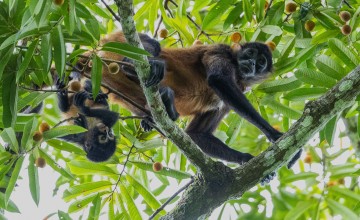
Erin
Spear
To understand the awe-inspiring diversity of tropical forests, we must pay as much attention to the biology of fungi, bacteria and other microbes, as that paid to rainforest trees during the last 100 years. New tools revealing relationships between plants and their associated organisms make this the Century of Microbial Ecology.
Projects and Stories
Research Focus
Research in our lab integrates disease ecology, mycology, and community ecology. We explore the nature and outcomes of plant-microbe interactions, as well as the ecology and epidemiology of fungal pathogens of tropical trees, using a combination of surveys and experiments in the forest, greenhouse, and lab.
Additional links
Contact
Research Overview
How do species intensely competing for the same resources coexist in diverse communities?
Disease carries negative connotations. In agriculture, disease can mean the loss of food and revenue. However, in species-rich forests, pathogens can promote the overall health of the forest by preventing any single tree species from monopolizing limited resources and becoming overly abundant, leading to the loss of other tree species with key ecosystem roles. Importantly, in this self-reinforcing system, the spread of disease is limited, and epidemics are avoided by the very plant diversity pathogens are maintaining. Currently, we have an incomplete understanding of fungal pathogens in tropical forests and their interactions with plants, despite their ubiquity and ecological and economical importance. This hinders our ability to detect and predict the impacts of exotic fungi, reductions in tree diversity in human-modified landscapes, and plant-microbe responses to a changing climate.
What is the role of multi-host pathogens in the maintenance of tropical forest diversity?
Pathogens exhibit a continuum of specificities. Some infect across host families and orders (generalists), others are limited to specific host species or genotypes (specialists). For free-living, dispersal-limited pathogens inhabiting species-rich host communities, selection should favor an ability to infect a variety of unrelated hosts. Indeed, many seedling pathogens in Panama’s diverse lowland forests exhibit host generalism. Yet, on local scales, analyses of spatial and temporal patterns suggest host-specific pathogens are limiting the abundance of a given species. How do we reconcile these findings? We are exploring non-mutually exclusive mechanisms by which multi-host pathogens could produce the patterns attributed to host-specific pathogens. Our lab is also interested in the factors dictating the host range of plant-associated pathogens in hyperdiverse tropical forests.
What factors exclude certain species from otherwise suitable habitats?
Disease varies across environmental gradients that impact pathogen and plant fitness. Tree species adapted to environments with elevated disease pressure are under selection to invest in disease-resistance and tolerance traits, despite the costs of those traits. Conversely, the fitness costs of defenses outweigh the benefits for tree species adapted to environments with reduced disease pressure. Consequently, poorly defended, disease-sensitive tree species can be excluded from disease-prone areas while well-defended, disease-tolerant species can persist. We are exploring disease gradients and interspecific variability in disease susceptibility to evaluate the role of microorganisms in the spatial turnover of tree species and, thereby, the maintenance of local and regional forest diversity.
How are microorganisms distributed across space and time, and what are the constraints?
We are testing five interlinked hypotheses: (1) fungal pathogen communities are diverse and differences in diversity across geographic space are driven by abiotic factors, and are largely independent of plant community diversity. The majority of pathogens are (2) host generalized and (3) relatively geographically widespread, spanning the Isthmus of Panama and associated abiotic and floristic gradients, but (4) their relative abundances are spatially and temporally variable. (5) A given pathogen’s spatial distribution and abundance are decoupled from the presence of a single host species. To do this, we use a combination of culturing, metabarcoding, and other molecular diagnostic techniques to identify plant-associated fungi, particularly pathogens, and to describe their spatial and temporal distributions, and host associations.
What makes a pathogen a pathogen?
Symbiotic relationships are omnipresent. Yet, we are just beginning to understand and characterize the nuanced nature of these relationships, particularly in tropical forests. Symbioses represent a continuum, from beneficial to detrimental for the host. Moreover, these relationships are not fixed in time and space, they are highly context dependent. A commensal microbe can become pathogenic when a plant’s health or nutritional status changes and plant-microbe mutualisms can fracture when a partner cheats. Moreover, a pathogen can actually benefit a host plant if the pathogen does more harm to the host plant’s neighbors who are competing for the same resources (sensu the enemy of my enemy is my friend).
Education
Ph.D., University of Utah (2015)
B.S. Biology (Honors), minor Environmental Studies (2005)
Selected Publications
Spear, E. R. and K. D. Broders. 2021. Host-generalist fungal pathogens of seedlings may maintain forest diversity via host-specific impacts and differential susceptibility among tree species. New Phytologist 231: 460–474.
Spear, E. R. and E. A. Mordecai. 2018. Foliar pathogens are unlikely to stabilize coexistence of competing species in a California grassland. Ecology 99: 2250-2259.
Spear, E. R. 2017. Phylogenetic relationships and spatial distributions of putative fungal pathogens of seedlings across a rainfall gradient in Panama. Fungal Ecology 26: 65–73.
Spear, E. R., P. D. Coley, and T. A. Kursar. 2015. Do pathogens limit the distributions of tropical trees across a rainfall gradient? Journal of Ecology 103: 165–174.


